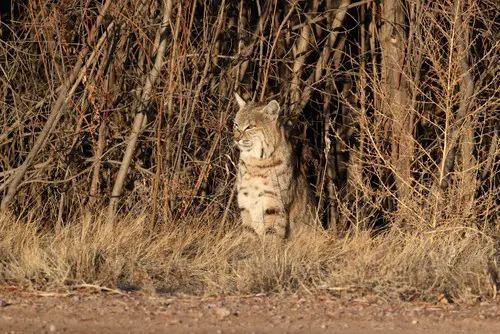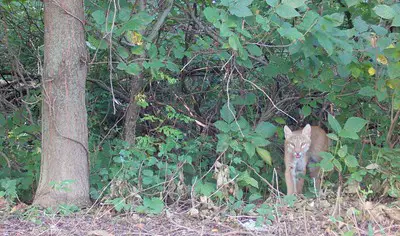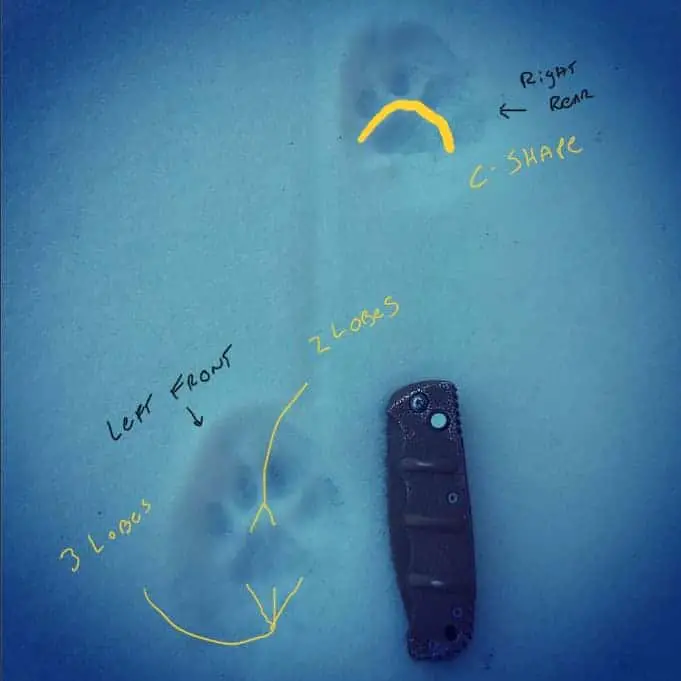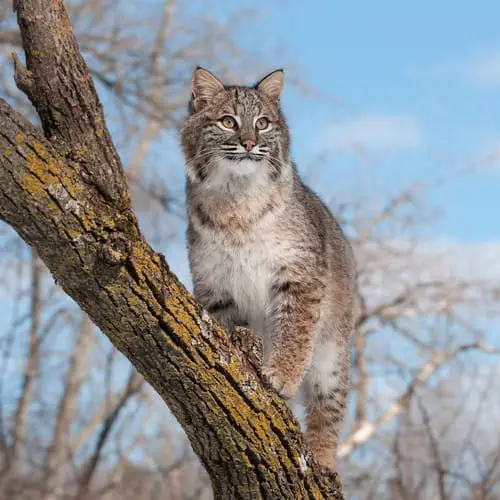Are bobcats dangerous to you or your pets? Well, bobcats are not a common sight for most people. Bobcats may live in many parts of the United States, but their adaptability and stealthy hunting habits make them nearly invisible to most people.
But are hidden, ordinarily nocturnal, bobcats dangerous when encountering humans or their pets?
Yes, it is rare when a bobcat attacks humans or their pets, but a little understanding of their behavior and taking a few simple steps will help you avoid conflicts.
This article will explore the general characteristics and behavior that might make bobcats dangerous to humans. Then, we will discuss how to reduce the risks and what precautions to take should you encounter one in the wild.

Are bobcats dangerous?
Bobcats are medium-sized wild cats native to North America, known for their distinctive tufted ears and spotted coats. They are skilled hunters in various habitats, including forests, grasslands, and urban areas.
In terms of their place in the ecosystem, bobcats play a crucial role as predators. They help control populations of small mammals, such as rabbits and rodents, which can prevent overgrazing and other negative environmental impacts. Bobcats are also an important food source for larger predators, such as wolves and mountain lions.
Despite their importance, bobcats face several threats, including habitat loss and conflict with humans. In addition, as urban areas expand, bobcats may come into contact with humans more frequently, increasing the risk of conflict. Therefore, it is essential for both humans and bobcats to coexist peacefully and to take precautions to avoid conflicts and protect these valuable animals.
Overall, bobcats are vital to the ecosystem and deserve our respect and protection. By learning more about these fascinating animals, we can better understand their place in the world and work to preserve their natural habitat.

Are bobcats dangerous: An introduction to the Bobcat.
Bobcats are medium-sized wild cats native to North America, known for their distinctive tufted ears and spotted coats. They are typically between 2 and 3 feet long, with a short tail that measures about 5 inches. They have a sturdy build and weigh anywhere from 15 to 35 pounds, depending on the region and prey availability.
Bobcats have short, dense fur that ranges in color from light brown to reddish-gray, with black spots and bars on the legs, tail, and face. In addition, they have a distinctive white underbelly and black ear tufts that give them their characteristic appearance.
Regarding physical adaptations, bobcats are well-suited to their role as predators. They have powerful legs and paws, with retractable claws that allow them to climb trees and capture prey. They also have excellent vision and hearing, which helps them to locate prey and avoid predators.
Overall, the physical characteristics of bobcats make them well-equipped to thrive in various habitats and environments. In addition, their adaptability and stealthy hunting habits make them an essential part of the ecosystem.

The dangerous bobcat? Bobcat home and range.
Bobcats reside throughout much of North America, including most of the United States, southern Canada, and parts of Mexico. They are adaptable animals and can be found in various habitats, including forests, grasslands, deserts, and even urban areas.
In terms of their preferred habitat, bobcats prefer areas with thick cover, such as dense forests or brushy areas. These provide them with the necessary cover to hunt and hide from predators. However, they are also found in grasslands and deserts, where they prey on small mammals such as rabbits and rodents.
Bobcats are solitary animals with a relatively small home range, typically covering about 5 to 15 square miles. They are territorial and will mark their territory with urine, feces, and scratch marks to deter other bobcats from entering.
Despite their wide range, bobcats face several threats, including habitat loss and conflict with humans. In addition, as urban areas expand, bobcats may come into contact with humans more frequently, increasing the risk of conflict.
Therefore, it is vital for both humans and bobcats to coexist peacefully and to take precautions to avoid conflicts and protect these valuable animals.
Overall, the habitat and range of bobcats are wide and varied, and they can adapt to various environments. However, it is crucial to understand and respect their territory to coexist peacefully.

The dangerous bobcat’s diet: Where your pet may get into trouble.
Bobcats are skilled predators and can hunt a wide variety of prey, including small mammals, birds, and reptiles. In addition, they are opportunistic hunters and will take whatever game is most readily available, depending on the season and the region.
In terms of small mammals, bobcats are known to prey on rabbits, rodents, and other small animals. They also hunt birds, such as doves, quail, and pheasants, and reptiles, such as snakes and lizards.
Bobcats are solitary hunters and typically hunt at dawn and dusk, using their excellent vision and hearing to locate prey. They are stealthy and patient, stalking their prey and waiting for the right moment to strike.
They use their powerful legs and retractable claws to capture and kill their prey and will often drag the carcass to a safe location to consume it.
In terms of their hunting habits, bobcats are known to be adaptable and adjust their hunting strategies depending on prey availability.
For example, they may switch to hunting during the day if their preferred prey is more active.
Overall, bobcats’ diet and hunting habits are varied and adaptable, allowing them to thrive in various environments. While they are skilled predators, it is essential to remember that they play a vital role in the ecosystem by controlling populations of small mammals and serving as a food source for larger predators.
Bobcats are not usually dangerous to either pets or humans.
Bobcats are generally not a threat to humans, but encounters with these wild cats can sometimes occur. Therefore, it is important to understand the factors that may increase the likelihood of a conflict and to take precautions to avoid conflicts with bobcats. This article will explore the risks and precautions to take if you encounter a bobcat in the wild.
Habitat loss and dangerous bobcats.
Bobcat attacks on humans are sporadic and usually occur when a bobcat is sick or injured and unable to hunt its typical prey. In most cases, bobcats will avoid humans and prefer to flee if confronted. However, it is vital to understand the risk of an encounter and take precautions to avoid conflicts with these wild animals.
There are a few factors that may increase the likelihood of an encounter with a bobcat, including:
- Habitat loss: As urban areas expand, bobcats may come into closer contact with humans and may be more likely to go into a residential area in search of food.
- Feeding: If a bobcat becomes accustomed to being fed by humans, it may lose its natural fear of humans and become more likely to approach or attack.
- Disease: If a bobcat is sick or injured, it may be more likely to attack humans for self-defense.
To avoid conflicts with bobcats, it is important to respect their territory and avoid approaching or feeding them. If you encounter a bobcat in the wild, give it plenty of space, and do not try to get near or touch it. If a bobcat appears sick or injured, it is best to contact a wildlife professional for assistance.
Overall, bobcat attacks on humans are rare, but it is important to be aware of the risks and take precautions to avoid conflicts with these wild animals.
Avoiding conflict with dangerous bobcats.
Bobcats are generally not a threat to humans, but encounters with these wild cats can sometimes occur. To avoid conflicts with bobcats, it is essential to understand their behavior and take precautions to minimize the risk of an encounter. Some tips for avoiding conflicts with bobcats include:
- Respect their territory: Bobcats are territorial animals and will mark their territory with urine, feces, and scratch marks to deter other bobcats from entering. Respecting their territory and avoiding approaching or touching a bobcat is important.
- Keep your distance: If you encounter a bobcat in the wild, give it plenty of space, and do not try to approach or touch it. Bobcats fear humans and prefer to flee if given the opportunity.
- Do not feed bobcats: If a bobcat becomes accustomed to being provided by humans, it may lose its natural fear of humans and become more likely to approach or attack. It is important to avoid feeding bobcats and to keep trash and other food sources secure to prevent attracting these animals.
- Protect your pets and livestock: If you have pets or livestock, it is vital to take precautions to protect them from bobcats. Keep pets inside or supervise them when they are outside, and use fencing or other barriers to protect livestock.
Overall, the key to avoiding conflicts with bobcats is to respect their territory and give them plenty of space. Understanding their behavior and taking precautions makes it possible to coexist peacefully with these fascinating animals.
Observing potentially dangerous bobcats.
Bobcats are fascinating animals, and many people are interested in observing them in their natural habitat. However, if you are interested in safely watching bobcats from a distance, there are a few steps you can take:
- Keep your distance: Bobcats fear humans and prefer to flee if given the opportunity. It is vital to provide them with plenty of space and avoid approaching or touching them.
- Use binoculars or a spotting scope: If you want to look closely at a bobcat, consider using binoculars or a spotting scope. This will allow you to safely observe the animal from a distance without disturbing it.
- Stay quiet and still: Bobcats have excellent hearing and are sensitive to noise and movement. If you want to observe a bobcat, it is important to stay quiet and still to avoid attracting its attention.
- Respect their territory: Bobcats are territorial animals and will mark their territory with urine, feces, and scratch marks to deter other bobcats from entering. It is essential to respect their environment and avoid disturbing them.
By following these tips, you can safely observe bobcats from a distance and appreciate their beauty and behavior without disturbing them.
Are bobcats dangerous: What to do when one approaches.
Bobcat attacks on humans are sporadic, but it is essential to know what to do if a bobcat approaches or attacks you. If a bobcat comes to you, the best course is to give it plenty of space and avoid approaching or touching it. However, if the bobcat becomes aggressive or appears sick or injured, take the following steps:
- Stand your ground: Bobcats fear humans and prefer to flee if given the opportunity. If a bobcat approaches you, try to make yourself appear larger by standing up tall and holding your arms out to the sides.
- Make noise: Bobcats are sensitive to noise and may be deterred by loud noises, such as shouting or clapping. Try to make yourself heard in order to avert the bobcat from approaching.
- Use a deterrent: If a bobcat becomes aggressive or attacks, try to use a barrier to protect yourself. This could be a flashlight, umbrella, or another object that you can use to fend off the animal.
- Contact authorities: If a bobcat appears sick or injured, or if an attack occurs, it is important to contact local authorities or wildlife professionals for assistance. They will be able to assess the situation and take the necessary steps to protect you and the bobcat.
It is important to remain calm and protect yourself if a bobcat approaches or attacks. By understanding their behavior and taking the appropriate steps, it is possible to avoid conflicts and protect both humans and bobcats.
Are bobcats dangerous? Protecting pets and livestock.
Bobcats are skilled predators and may pose a risk to pets and livestock, particularly small animals such as cats, small dogs, and poultry. If you are concerned about protecting your pets and livestock from bobcats, there are a few steps you can take:
- Keep pets inside: If possible, keep your pets inside or supervise them when they are outside. This will help to protect them from bobcats and other predators.
- Use fencing or barriers: If you have livestock, consider using fencing or other barriers to protect them from bobcats. Choose a sturdy, tall fence to deter bobcats from climbing over it, and consider using additional obstacles, such as electric fencing, to provide an extra layer of protection.
- Remove attractants: Bobcats are attracted to food sources, so keeping trash and other food sources secure is vital to prevent attracting these animals. This includes securing trash cans, cleaning up spilled pet food, and keeping bird feeders out of reach.
- Use motion-activated lights: Bobcats are nocturnal animals and may be more active at night. Use motion-activated lights around your property to deter bobcats and other predators from approaching.
Overall, the key to protecting your pets and livestock from bobcats is to remove attractants, use barriers and fencing, and keep a close eye on your animals. Taking these precautions can help protect your animals and coexist peacefully with bobcats in your area.
Are bobcats dangerous? Not if you take precautions.
Bobcats are medium-sized wild cats native to North America, known for their distinctive tufted ears and spotted coat. They are found in various habitats, including forests, grasslands, and urban areas, and play a vital role in the ecosystem as predators and an important part of the food chain.
Bobcat attacks on humans are extremely rare, but it is important to understand the risks and take precautions to avoid conflicts with these wild animals. Some tips for avoiding conflicts with bobcats include respecting their territory, giving them plenty of space, and avoiding behaviors that may increase the likelihood of an encounter, such as feeding or approaching them.
If you encounter a bobcat in the wild, it is important to remain calm and give the animal plenty of space. If a bobcat approaches or becomes aggressive, try to make yourself appear larger, make noise, and use a deterrent to protect yourself. If a bobcat seems sick or injured, or if an attack occurs, it is important to contact local authorities or a wildlife professional for assistance.
It is vital to respect bobcats and coexist peacefully with these wild animals. By understanding their behavior and taking the appropriate precautions, we can protect humans, pets, and bobcats and appreciate their role in the natural world.


